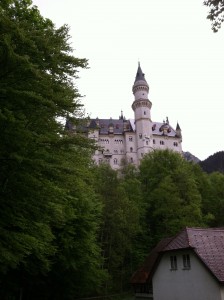by Andrea Karsesnick
One hundred and seventy-two days.
That’s how long King Ludwig II lived in Neuschwanstein Castle, a tall, white picturesque structure sitting high in the mountains of Hohenschwangau, Bavaria, Germany. The castle was the inspiration of Disneyland’s Sleeping Beauty castle, and it has been featured prominently in many films and German tourism videos.
King Ludwig was born on Aug. 25, 1845, in Bavaria in Schloss Nymphenburg. He began his reign as king in 1864 at the age of 18. He claimed to have accepted the throne too quickly and regretted it.
Ludwig II lived in a fantasy world. He wanted to believe in a “holy kingdom,” where each ruler was chosen by the divine right theory of kingship. In reality, Ludwig II was a constitutional monarch with duties.
He was a recluse, who secluded himself in his castle away from everyone and did not tend to his duties as king. The castle was never completed, although he moved into in 1884. In 1885, banks threatened to take away his property, and Ludwig II developed political enemies. He was arrested and interned in the Berg Castle in 1886. Ludwig II died of mysterious circumstances, an apparent drowning, on June 13 that year in Lake Starnberg. He died alongside his psychiatrist who had diagnosed him as insane.
He started to build it on the ruins of another castle. The construction of Neuschwanstein started in the summer of 1868 and was ready for Ludwig II to move in in the end of 1884, according to the castle’s official website. He only lived in the castle for a short period before his death. He only saw this home as a construction site.
Neuschwanstein was Ludwig II’s escape from reality. It was his dream world modeled on the Middle Ages. The paintings on the walls were done by seven different unknown artists from the academy in Munich. Famous artists did not want to work for Ludwig II because there would be little room for creativity in the artwork as Ludwig II had all of the ideas. Nonetheless, the paintings are extremely intricate and ornate.
Ludwig II did not want anybody to share his luxurious castle with anyone. However, the castle was open to the public seven weeks after his death. Today, roughly 1.4 million people visit the castle each year and there are nearly 8,000 visitors each day.
The Point Park University group’s tour guide cited her favorite part of the elaborate castle. Saura Samgabote, who has led tours there for seven years, says, “I love the details in the paintings. Every day I notice something I did not the day before.”
The decorated walls of Neuschwanstein were based on and inspired by the works of Richard Wagner, who was a good friend of Ludwig II. The paintings were inspired by his operas and medieval legends. There were three main figures on the walls of Neuschwanstein: Tannhaeuser, the swan knight Lohengrin and the Grail King Parzival.
Another theme used throughout the interior walls was religion. Ludwig II’s throne room was overseen by whom he saw as the highest king, Jesus. Ludwig II believed kingship to be “by the grace of God.”
The swan is also seen many times within the castle. Ludwig had a large swan statue and even door handles were modeled to form swan necks. The swan followed the religious theme as they are the Christian symbol of purity.
A basic ticket to the castle costs 12 euros. The visiting hours of the castle are from 9 a.m. to 6 p.m. April to 15 October. From Oct. 16 to March, the hours are shortened to 10 a.m-4 p.m. Tickets need to be purchased in advance, and visitors can only enter the castle’s rooms by guided tour. The castle is closed Dec. 24-25 and Jan. 1.
Visitors have to purchase tickets at the Ticketcenter Hohenschwangau in the village of Hohenschwangau below the castle. From Munich, tourists need to take a train and then a bus to the castle; it’s a very steep 30-minute walk to the castle from the village, although a bus and horse carriages are available.

